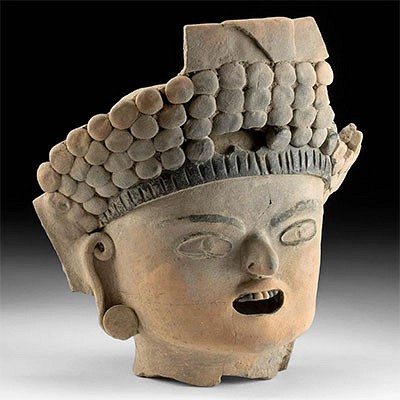19th C. Japanese Meiji Gilt Wood Zushi Shrine, Kannon
Lot 128a
About Seller
Artemis Gallery
686 S Taylor Ave, Ste 106
Louisville, CO 80027
United States
Selling antiquities, ancient and ethnographic art online since 1993, Artemis Gallery specializes in Classical Antiquities (Egyptian, Greek, Roman, Near Eastern), Asian, Pre-Columbian, African / Tribal / Oceanographic art. Our extensive inventory includes pottery, stone, metal, wood, glass and textil...Read more
Categories
Estimate:
$2,000 - $3,000
Absentee vs Live bid
Two ways to bid:
- Leave a max absentee bid and the platform will bid on your behalf up to your maximum bid during the live auction.
- Bid live during the auction and your bids will be submitted real-time to the auctioneer.
Bid Increments
| Price | Bid Increment |
|---|---|
| $0 | $25 |
| $300 | $50 |
| $1,000 | $100 |
| $2,000 | $250 |
| $5,000 | $500 |
| $10,000 | $1,000 |
| $20,000 | $2,500 |
| $50,000 | $5,000 |
| $100,000 | $10,000 |
| $200,000 | $20,000 |
About Auction
By Artemis Gallery
May 18, 2023
Set Reminder
2023-05-18 10:00:00
2023-05-18 10:00:00
America/New_York
Bidsquare
Bidsquare : Ancient | Asian | Ethnographic Art
https://www.bidsquare.com/auctions/artemis-gallery/ancient-asian-ethnographic-art-12797
Featuring classical antiquities, ancient, and ethnographic art from cultures encompassing the globe. Egyptian, Greek, Roman, Near Eastern, Asian, Pre-Columbian, Native American, African / Tribal, Oceanic, Spanish Colonial, Fossils, more! All legally acquired, legal to sell. Satisfaction guaranteed. Artemis Gallery info@artemisgallery.com
Featuring classical antiquities, ancient, and ethnographic art from cultures encompassing the globe. Egyptian, Greek, Roman, Near Eastern, Asian, Pre-Columbian, Native American, African / Tribal, Oceanic, Spanish Colonial, Fossils, more! All legally acquired, legal to sell. Satisfaction guaranteed. Artemis Gallery info@artemisgallery.com
- Lot Description
East Asia, Japan, Meiji Period, ca. 19th century CE. A finely carved and gilded zushi - a petite Buddhist shrine - portraying Kannon, the bodhisattva of compassion, in his remarkably elaborate thousand-armed form, known as Senju Kannon. Standing on a lotus pedestal, the deity's 4 front hands are joined together while numerous other arms reach out from his body, extending Kannon’s all-encompassing compassion and holding various instruments of his iconography. A scroll-adorned mandorla rises behind the tranquil figure whose round visage presents slender, downcast eyes, a sharp nose, full cheeks, and a petite mouth, all beneath an ornate diadem. Kannon is one of the most popular and most frequently depicted deities in Japanese Buddhism. His Thousand-Armed form grew in popularity in Japan as a bodhisattva capable of preventing and curing physical ailments, such as blindness. Size of open shrine: 9.3" W x 13.1" H (23.6 cm x 33.3 cm); of figure: 3.5" W x 10.5" H (8.9 cm x 26.7 cm); quality of gilding: 47.3 to 73.8% (from 11 to over 17 karats)
At the start of the Meiji Period (1868), the Japanese government declared that Buddhism must be separated from Shinto, the official state religion. Initially, enforcement of the separation was strict, and Buddhist images were stricken from many Shinto shrines. Within a few years, however, enforcement stopped, and Buddhist images crept back into Japanese religious art. A shrine like this one, depicting a Bodhisattva, was created during this time period.
A similar shrine can be found in the Metropolitan Museum of Art under accession number 67.55.62.
Provenance: private Hawaii, USA collection, acquired 2000 to 2010
All items legal to buy/sell under U.S. Statute covering cultural patrimony Code 2600, CHAPTER 14, and are guaranteed to be as described or your money back.
A Certificate of Authenticity will accompany all winning bids.
We ship worldwide and handle all shipping in-house for your convenience.
#178129Some chipping to enamel, gilding, and base. Expected nicks and abrasions, but otherwise very nice with good preservation of gilding and detail. Rich patina to figure.Condition
- Shipping Info
-
All shipping is handled in-house for your convenience. Your invoice from Artemis Gallery will include shipping calculation instructions. If in doubt, please inquire BEFORE bidding for estimated shipping costs for individual items.
-
- Buyer's Premium



 EUR
EUR CAD
CAD AUD
AUD GBP
GBP MXN
MXN HKD
HKD CNY
CNY MYR
MYR SEK
SEK SGD
SGD CHF
CHF THB
THB














